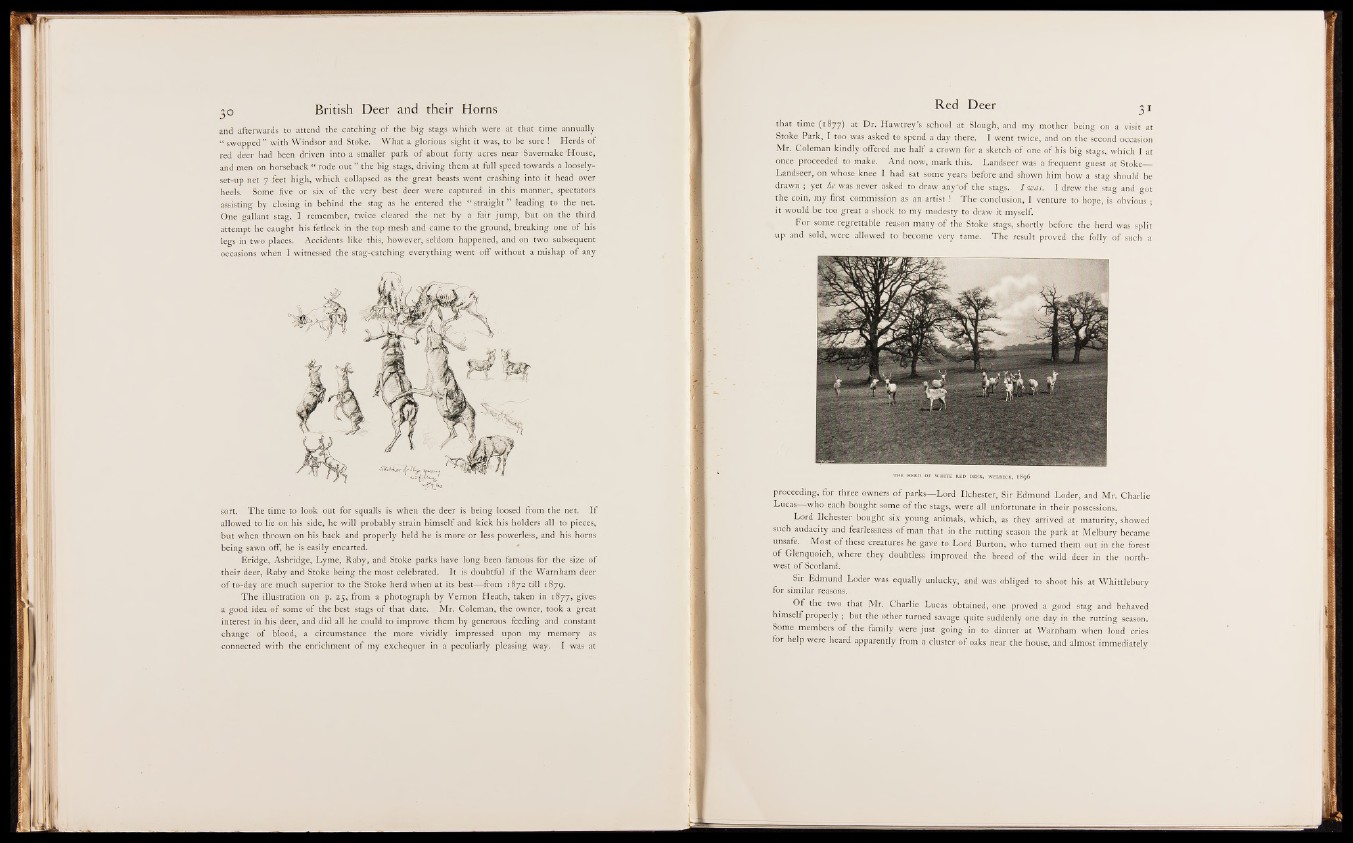
and afterwards to attend the catching o f the big stags which were at that time annually
“ swopped ” with Windsor and Stoke. What a glorious sight it was, to be sure ! Herds of
red deer had been driven into a smaller park o f about forty acres near Savernake 'House,
and men on horseback “ rode out ” the big stags, driving them at full speed towards a loosely-
set-up net 7 feet high, which collapsed as the great beasts went crashing into it head over
heels. Some five or six o f the very best deer were captured in this manner, spectators
assisting by closing in behind the stag as he entered the “ Straight ” leading to the net.
One gallant stag, I remember, twice cleared the net by a fair jump, but on the third
attempt he caught his fetlock in the top’mesh and came to the ground, breaking one o f his
legs in two places. Accidents like this, however, seldom happened, and on two subsequent
occasions when I witnessed the stag-catching everything went off without a mishap o f any
sort. T h e time to look out for squalls is when the deer is being loosed from the net. I f
allowed to lie on his side, he will probably strain himself and kick his holders all to pieces,
but when thrown on his back and properly held he is more or less powerless, and his horns
being sawn off, he is easily encarted.
Eridge, Ashridge, Lyme, Raby, and Stoke parks have long been famous for -the size o f
their deer, Raby and Stoke being the most celebrated. It is doubtful i f the Warnham deer
o f to-day are much superior to the Stoke herd when at its best— from 1872 till 1879.
T h e illustration on p. 25, from a photograph by Vernon Heath, taken in 1877, gives
a good idea o f some o f the best stags o f that date. Mr. Coleman, the owner, took a great
interest in his deer, and did all he could to improve them by generous feeding and constant
change o f blood, a circumstance the more vividly impressed upon my memory as
connected with the enrichment o f my exchequer in a peculiarly pleasing way. I was at
that time (1877) at Dr. Hawtrey’s school at Slough, and my mother being on a visit at
Stoke Park, I too was asked to spend a day there. I went twice, and on the second occasion
Mr. Coleman kindly offered me ha lf a crown for a sketch o f one o f his big stags, which I at
once proceeded to make. And now, mark this. Landseer was a frequent guest at Stoke_
Landseer, on whose knee I had sat some years before and shown him how a stag should be
drawn ; yet he was never asked to draw any"of the stags. I was. I drew the stag and got
the coin, my first commission as an artist ! T h e conclusion, I venture to hope, is obvious ;
it would be too great a shock to my modesty to draw it myself.
For some regrettable reason many o f the Stoke stags, shortly before the -herd was split
up and sold, were allowed to become very tame. T h e result proved the folly o f such a
THE HERD OF WHITE RED DEER, WELBECK, 1896
proceeding, for three owners o f parks— Lord Ilchester, Sir Edmund Loder, and Mr. Charlie
Lucas who each bought some o f the stags, were all unfortunate in their possessions,
Lord Ilchester bought six young animals, which, as they arrived at maturity, showed
such audacity and fearlessness o f man that in the rutting season the park at Melbury became
unsafe. Most o f these creatures he gave to Lord Burton, who turned them out in the forest
o f Glenquoich, where they doubtless improved the breed o f the wild deer in the northwest
o f Scotland.
Sir Edmund Loder was equally unlucky, and was obliged to shoot his at Whittlebury
for similar reasons.
O f the two that Mr. Charlie Lucas obtained, one proved a good stag and behaved
himself properly ; but the other turned savage quite suddenly one day in the rutting season.
Some members o f the family were just going in to dinner at Warnham when loud cries
for help were heard apparently from a cluster o f oaks near the house, and almost immediately